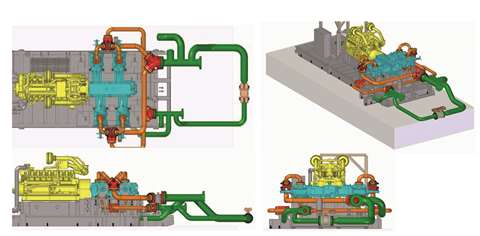PAN manifold technology used to control pulsations
October 27, 2022
 The fifth generation of PAN manifolds is a technology that shows a significant amount of a compressor’s pulsation energy can be used to increase flow and efficiency. (Illustration: ACI Services)
The fifth generation of PAN manifolds is a technology that shows a significant amount of a compressor’s pulsation energy can be used to increase flow and efficiency. (Illustration: ACI Services)
Vibrations have been a known problem to the operators of reciprocating compressor for decades. The compressors suck in a mass of gas and deliver a mass of gas on an intermittent basis, leading to changes in pressure which vary with time. These rapid changes in pressure can lead to pulsation in the compressor and the piping from it.
Pulsation in the compressor and piping can lead to vibrations on anything that is connected to it. If those vibrations hit the natural frequency of the equipment, things can break.
““It’s a big problem. It’s a safety issue,” said Norm Shade, senior consultant and president emeritus at ACI Services.
Researchers developed pulsation control bottles and orifice plates back in the 1950s to mitigate the vibrations. Experience showed that the best results came when the operators worked to control pulsation as close to the compressor as possible. This technology is well developed and generally effective for natural gas streams.
Designers introduced pulsation control bottles with internal or external choke tubes and multiple orifice plates to dissipate the pulsation energy so that the compressor can operate safely.
However, this solution results in pressure losses that cuts compressor efficiency and gas flow. To complicate matters, the introduction of hydrogen into the flow may reduce the effectiveness of the pulsation control bottles and further reduce a compressor’s energy flow rate.
Hydrogen blend
Hydrogen poses unique challenges for compressors because its physical characteristics are different from natural gas. It has a higher speed of sound, which changes the compressor system’s resonant lengths, which can cause higher pulsations and vibrations. Hydrogen also has a lower gas density and a lower volumetric energy density. Existing systems used to control pulsation and vibration may not be effective.
As operators give more consideration to blending natural gas with hydrogen, the traditional system for controlling vibrations may not be effective on a blend of different gases.
Their functionality depends on a large part on the speed of sound of the gas, which is inversely proportional to the square root of the molecular weight of the gas. The molecular weight of natural gas is typically about 16.7, while the molecular weight of hydrogen is 2.016.
“That’s a big difference,” he said.
A blend of hydrogen and natural gas would fall somewhere between the two.
If the molecular weight of a given gas changes, its speed of sound would also change, making traditional acoustic dampeners less effective, or completely ineffective.
Complicating matters further for the compressor designers is the fact that the blend of hydrogen in a gas stream may change over time. A system that might be effective with a blend of 20% hydrogen might not work if that blend drops to 10% or 0%, a possibility if hydrogen is blended into natural gas stream.
The PAN manifold technology, developed to reduce pulsations and improve efficiency and flow rate on compressors, can handle pulsation control as the hydrogen percentage drifts.
“This system works very well with variable blends of hydrogen,” he said. “We’ve effectively modeled 28% and looked at higher concentrations as well.”
The performance augmentation network (PAN) system developed by Optimum Power Systems takes a different approach. Instead of dampening pulsations, the system uses that energy to make the compressor operate more efficiently, while simultaneously cancelling pulsation in the pipeline to very low levels. By canceling the detrimental gas pulsations, it prevents them from traveling upstream and downstream from the pumping station and minimizes the dangerous shaking forces that they impose on piping and equipment in the system.
The PAN manifold system reflects pressure waves back to individual cylinder suction and discharge flanges at precise times during the compression cycle when the valves are open. Proper pressure wave timing increases the flow rate and reduces the amount of input work and power required by the compressor to boost pressure from the plant’s suction header to its discharge header. This is similar to how tuned manifolds act on high-performance reciprocating engines.
Performance augmentation network (PAN) manifold technology requires tuned pipe lengths, special junctions and (in the latest version), quarter wave resonators (QWR.) Designers can use the technology to manage pulsation energy in gas compressors, and to reduce power consumption or to increase flow rates. The technology is inherently insensitive to variable concentrations of hydrogen in natural gas.
The PAN technology uses a portion of the compressor’s pulsation energy to boost flow and efficiency. A carefully designed PAN manifold can reflect pulsation energy back into the compressor’s cylinder flanges to increase flow and reduce the power required for compression.
The PAN manifold technology was originally developed by Optimum Power Technology, which later became Optimum Pumping Technology. The Pennsylvania-based company had designed manifold technology to boost the performance of race cars for decades and it was commonly used in NASCAR.
Randy Raymer, an engineer with the former El Paso Corp. was interested to see if the technology could be adapted to compressors to be more efficient. He invited ACI Services to get involved to see if the system could be used to boost performance and eliminate pulsations without significant pressure loss.
The partners made multiple simulations with funding from the GMRC and then verified the numbers on a field test at an El Paso compressor station in 2008. Shade and Chatfield have presented their research at several Gas Machinery Conferences.
The field tests showed the technology is effective, prompting Optimum Power to partner with ACI Services to retrofit multiple units operating in the field.
In a recent presentation to the Gas Machinery Research Council’s annual conference, Norm Shade, Sr. Consultant and President Emeritus at ACI services, and Glen Chatfield, President at Optimum Pumping Technologies, explained how this technology would work with varying blends of hydrogen in a natural gas stream.
The technology was first installed in 2008 and was tested on a four-throw 1000 rpm reciprocating compressor. Early field testing was supported by the Gas Compressor Research Council. By 2019, the design was updated for a fourth and fifth generation, which has the ability to control pulsation and increase energy delivery capacity of reciprocating compressors operating a mix of natural gas with up to 28% of hydrogen by volume. The fourth generation iteration of the technology was installed on 6000 hp reciprocating compressors in 2019. The fifth generation makes the system easier to install and eliminates the complex elevated suction manifold, which reduces vibration and improves access to the compressor for maintenance.
PAN manifolds on reciprocating compressors have been simulated and field tested on reciprocating compressors with speed ratings of 750, 1000 and 1400 rpm and power rating from 1380 to 6000 hp. Those tests on traditional pipeline natural gas mixtures have shown improved thermodynamic efficiency improvements while controlling side pulsations within API 618 limits.
Since the units were first field tested, several major pipeline operators have installed the PAN manifold technology on compressors operating in the field. The most recent was in 2019, when Tallgrass Energy chose ACI Services to install its PAN manifold technology on two reciprocating compressor units at the Chandlersville compressor station in Philo, Ohio.
New inquiries
The system works best when it is installed on a compressor package from the ground up, but ACI and Optimum generally retrofit it onto existing units. The retrofits force the designers to install the piping around existing equipment, on existing foundations or next to existing walls, all of which make the installation more complicated.
“You have to work around that, but it is possible,” he said.
As the industry looks increasingly at using hydrogen in its natural gas lines, Optimum and ACI Services have seen new inquiries from operators looking to try the technology. A major pipeline operator wants to retrofit a PAN manifold system on a compression system that draws natural gas from a storage cavern. The facility has two compressors, one of which is not fully utilized. The midstream operator wants to see if installing the PAN system on one compressor will allow them to eliminate the second unit.
“It looks like by putting a PAN system on one of the units, we can boost its flow rate with the same driver to shut down the second unit,” he said.
“There is real interest in this technology. This is an enabling technology that would significantly increase efficiency on any gas and eliminate some operating and safety concerns with variable blends of hydrogen.”
MAGAZINE
NEWSLETTER

CONNECT WITH THE TEAM








